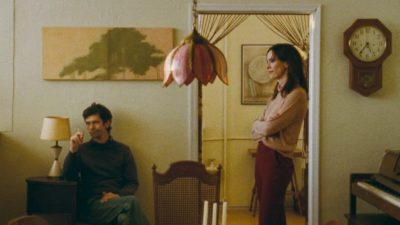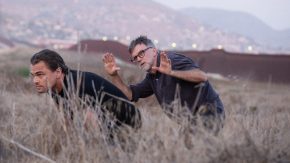The story of an investigation: the Hungarian National Dance Ensemble’s grand premiere at Müpa Budapest, The Faithless Wife, works with the gloominess of ballads but in a contemporary way. One of the most treasured pieces in old Hungarian ballad repertoire, Barcsai’s Lover is the starting point for a full-length crime dance drama. The wife who cheats on her husband faces terrible punishment, but how and why did it come to this? We spoke to Zoltán Zsuráfszky, Kossuth Prize-winning dance artist and artist of the Nation, artistic director of the Hungarian National Dance Company and choreographer-director of the production, about the monumental performance.
The piece was commissioned by Müpa Budapest. What was the subject of the request, what kind of performance did they want to see on stage?
It is a great honour for us to be the resident ensemble of Müpa Budapest for the 2023/24 season and to be able to present this piece on its stage. Before the covid pandemic, we were asked to stage a dance piece with a theme that would be of interest to people all over the world, so that we could then use this performance to showcase the unique strength and diversity of Hungarian folk dance and folk music abroad. The Faithless Wife, which we prepared during the pandemic, deals with a subject that concerns everyone. It’s about eternal and timeless emotions, about choosing our partner and how it can go wrong, and we bring the most mysterious and deepest human emotions to life.
How did you choose the Transylvanian folk ballad Barcsai’s Lover, and what works so well on stage in it?

(c) Sándor Csudai
The images of the ballad are clearly destined to go on stage. Such a motif is the woman wrapped in a dagger and then burnt, with the whole community, with faces painted white, participating in the presentation of the victim. Meanwhile, the viewer identifies with young people who have loved each other for a long time, separated not only by the girl’s parents but also by the events of the world. In fact, all the characters in this play are victims, and we try to make this as authentic as possible.
The story follows an imaginary investigation. What is it about and where does the idea come from?
My wife, the professional director of the ensemble and co-director of the show, Zsuzsa Zs. Vincze, stage director and co-director of the ensemble, wrote this play. She gave it the subtitle: a criminal dance drama. We present and project emotions and spiritual struggles in this performance. The objective and obscure message of this ballad, which is very cruel by today’s standards – that the ‘guilty’ adulterous wife is punished by death by her jealous husband – was explored from a different angle. In an imaginary “investigation”, our performance explains the infidelity of a woman who cannot forget her first and true love and flees her bad marriage into the arms of her lover, who returns home after a long time in hiding.
What kind of folk dances are in the piece? Does it preserve the Szekler origins, was it an aim at all?
This time we did not tie ourselves to the Szekler origin. At the beginning of the performance, we enter into a Kalotaszeg wedding feast, where it becomes clear that our female protagonist is mourning her ex-lover. Then, starting from Moldavia and moving on to the Hungarian countryside, we show the passage of time and the changing seasons in the language of dance. The finale is abstract and offers a wide range of artistic means of expression in which the various motifs are superimposed.
A large-scale performance has been staged, with a serious visual world.
Indeed, this is the work of the Honvéd Ensemble, with hundreds of actors on stage, 42 dancers from the Hungarian National Dance Ensemble, the ensemble’s orchestra and the Honvéd Male Choir. The result is a very large-scale show with a series of huge scenes. I must mention Kázmér Tóth’s monumental sets, which create an almost operatic scenery, as they contribute greatly to amplifying what is said through dance and music.
Benjámin Eredics is the composer of the piece.
Yes, he dreamed up this music, composing a choral work of overwhelming power for the Honvéd Male Choir. In addition to István “Gázsa” Papp and Sándor D. Tóth’s work as editor of folk music, the evening’s diverse world music material is also the work of the young composer who won the Müpa Music Competition’s award for incidental music for dance performances.
The choir also dances in this piece. What was this part of the process like, and how open were the choir members to this task?
I gave a very exciting movement to our choir of forty-six people, who were soldiers in the performance. I always enjoy working with them, and we have several performances together. I started teaching them different claps and steps, and we had to combine them with singing. It was also a good challenge for them, they were not against it, they are really enjoying it and eagerly preparing for this performance. I think we have managed to create an all-round artistic performance of the ballad.
In an interview you mentioned that the original folk dance elements are complemented by contemporary folk dance and the so-called Molnár technique. What can we know about this?
István Molnár was a contemporary dance artist of the 1940s who was deeply involved in authentic folk dance, and we know him as the leader of the SZOT Art Ensemble. He was a significant figure in Hungarian folk dance and taught many folk dancers in the post-war period. He created a kind of contemporary technique, somewhere between ballet and folk dance, which can be taught and enjoyed to this day, and which can be used to tell stories and create a working language. I used it to build up certain pas de deux, lifts and turns.
Why is this close to your heart among the many performances?
The decades of work I have done with the Dance Company are divided into eras. This is such an epochal performance, which is special in many ways, and therefore of great importance to me. The participation of the chorus, the varied dance elements, the special visual world, the regularity required by the ballad genre, the dynamism of the performance, the spectacle of the emotions presented, all make it unforgettable for creators and audience alike. To perform it on the stage of Müpa Budapest is a special experience, as we can work under excellent conditions.
Article: Anna Rácz
Translation: Zsófia Hacsek

























Comments